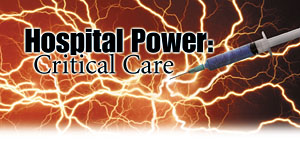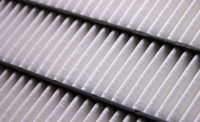

The loss of normal power at a medical facility, whether the result of a natural disaster or system failure, is a situation that every health care engineer must anticipate. Certain hvac equipment is required by the National Electric Code or mandated by the authority having jurisdiction (AHJ) to be connected to the emergency power system of a hospital. Hvac systems that are not code required or mandated for connection to the emergency power system may still need to operate to meet the facility's needs during a number of critical situations.
Performing a hazard vulnerability analysis as outlined by the Joint Commission on Accreditation of Healthcare Organizations (JCAHO) is the best way to begin to establish the extent of the hvac emergency power requirements that are above the minimum required by code or otherwise mandated. The first step, however, is to understand the code requirements.
Code required systems
The National Electric Code (NEC) and National Fire Protection Association Standard for Healthcare Facilities (NFPA 99) require certain hvac systems to be connected to the emergency power system in a hospital. The following is a summary of those hvac systems:Generator-related equipment
- Fuel pumps;
- Damper operators and controls;
- Ventilation and combustion air fans; and
- Remote radiator fans.
Fire safety systems
- Smoke control systems including exhaust fans, air-handling equipment, and controls;
- Stair pressurization equipment and controls; and
- Kitchen hoods.
Heating equipment to maintain inside design temperature where the outside design temperature is lower than +20°F
- Operating rooms and associated support spaces;
- Labor and delivery rooms and associated support spaces;
- Recovery areas;
- Intensive care and coronary care units;
- Nurseries;
- Protective and infectious isolation rooms;
- Emergency treatment spaces; and
- General patient rooms.
Supply, return, and exhaust air systems serving the following areas
- Surgical and obstetrical delivery suites and associated support spaces;
- Intensive care and coronary care units;
- Protective and infectious isolation rooms;
- Emergency treatment spaces;
- Exhaust fans for fume hoods and radio-isotope hoods; and
- Ethylene oxide evacuation and anesthesia evacuation systems.
The hvac systems and equipment listed above are considered to be the minimum requirements in an acute care hospital. Additional state and local requirements will add to the minimum requirements. These requirements should be understood prior to the start of any design.
Recommended systems
With respect to the operation of a hospital, it is important to understand the need for those hvac systems that may not be mandated for connection to the emergency power system to remain in service during a loss of normal power. Often, it is only after the hospital experiences a loss of power for an extended duration that deficiencies are uncovered.Outlined below are the systems and equipment frequently overlooked due to a lack of understanding of the equipment and procedures needed during a loss of power.
The following should be placed on emergency power under most circumstances.
- Building automation system:
- Head-end computer;
- Control panels;
- Control air compressors and dryers; and
- Any electric controls serving systems on emergency power.
- Refrigeration system and controls for food storage and clinical laboratory refrigerators and freezers.
- Hvac systems serving telecommunication rooms and computer rooms.
- Water chillers, pumps, and controls for MRIs, CT scanners, and linear accelerators - city water cooling as a redundant source of cooling may be allowed in some jurisdictions.
- Autopsy room exhaust air systems and refrigeration systems for body cold boxes.
- Supply, return, and exhaust air systems serving bone marrow treatment areas.
- Supply and general exhaust air serving the clinical laboratory to maintain pressure relationships.
- Electric heat tape for exposed piping, absorption chillers to prevent crystallization, oil sump heaters on electric centrifugal chillers.
It is critical that the criteria for the systems required to be connected to emergency power be established as early in the design phase as is possible. Major system decisions are dependent on an early understanding of these issues. As an example, the number of air-handling units (AHU) and what departments they will serve can have an impact on the size of the mechanical rooms, as well as the size of the emergency generator.
HVAC system impact on generator size
Hvac systems have a significant impact on the emergency power system of a hospital. The connected load of the hvac equipment can range from 3 to 6 W/sq ft in an acute care facility. This is generally 50% to 60% of the entire load on the emergency generator plant. With the typical cost of an emergency generator plant ranging from $800 to $1,200/kW of generator capacity, the cost of adding 100 hp of motor load could be as high as $90,000.It goes without saying that care must be taken when determining what hvac equipment is required to be connected to the emergency power system. Establishing an appropriate balance between the cost of adding equipment to the emergency generator and the risk of not having hvac service during a loss of power is a difficult task.
Mechanical cooling is one of the most difficult issues to resolve in establishing the criteria. There are certain departments of a hospital that should have provisions for providing air conditioning even when normal power is not available. The operating suite, postanesthesia care units, and the intensive care units are areas of the hospital where patient safety may be compromised if the rooms are outside certain temperature and humidity requirements. In certain warm and humid climates, consideration should be given to providing mechanical cooling in all patient rooms and diagnostic and treatment areas.
What can happen during the loss of normal power
At a recent planning meeting to discuss a major expansion to the operating suite of a 350-bed hospital, the director of facilities described what happened during the loss of normal power at his facility. It was 3 p.m. and the temperature was 95° with extreme humidity. A line of severe thunderstorms had resulted in a loss of normal power at the hospital. The emergency generators were running hot and concern was growing that they may shut down due to the high temperature.As the outage continued into the second hour, the situation was becoming much more severe inside the hospital. The AHUs that are required to be connected to the emergency power system for ventilation of the critical areas were running. The problem was that the minimum outside air dampers were open and the system was pumping hot and humid air into the critical areas. Fortunately, the scheduled surgeries for the day were complete, but doctors and nurses were calling from all areas of the hospital with urgent requests for cooling as concern for patient safety grew. The power was back by 6 p.m. and the conditions slowly improved.
After the event, the director of facilities was under pressure from the hospital administrators and doctors to explain how this could have happened. They were amazed to find out that cooling was not available after a power outage caused by something as common as a thunderstorm. The answer could be traced back to a value engineering decision made during the last hospital expansion. The chiller plant needed additional capacity to serve the proposed expansion and a new emergency generator and electric centrifugal chiller were proposed for the chiller plant.
One cooling tower, one condenser water pump, one primary chilled-water pump, and one secondary pump were to be added to the new emergency generator in addition to the new chiller. Unfortunately, the cost for this solution was value engineered and the emergency generator was deleted after the bids for the expansion project were over budget.
Providing air conditioning to critical areas during a loss of normal power can require a significant amount of electricity. A typical 300-bed hospital will require approximately 300 tons of cooling to offset the cooling load in the critical areas of the facility. Even the most efficient, water-cooled, electric centrifugal chiller would require approximately 300 kW of emergency power when all ancillary pumps and cooling towers are included.
The cost of connecting this mechanical cooling system to an emergency generator could be as high as $360,000. The range of these costs will obviously vary on each project, however, the magnitude of the costs justify an analysis of alternate strategies for providing mechanical cooling upon a loss of normal power.
Alternate cooling strategies
There are many strategies that will allow a facility to achieve partial mechanical cooling during a loss of normal power. A central chiller plant where at least one chiller is driven by something other than an electric motor - a natural gas-fired absorption chiller, natural gas engine-driven chiller, or steam absorption chillers - are the most common choices. Other less common strategies are coupling a generator directly to the electric chiller or some form of thermal storage. Any of these strategies should be part of a larger energy strategy.Trying to guess what energy prices will do over the course of the next five years or even five months is nearly impossible. The best recommendation for managing the volatility of energy prices over the life of an hvac system is the same advice given for good fiscal planning - diversify. A carefully thought-out energy strategy that does not rely on any single energy source for all heating or cooling needs can have many benefits.
The ability to switch to the least expensive fuel to produce chilled water during times of peak demand will lead to lower utility costs than the competing hospital who has decided to take the lowest first cost approach to chilled water and steam production. A secondary benefit to the diversification of energy usage is the ability to produce chilled water for the critical areas of the hospital with minimal investment when compared to the cost of electrically driven chillers or direct-expansion equipment connected to the emergency power system.
Emergency generator coordination
Another issue that must be considered in the design of a safe and reliable hvac system is the effect of the major hvac systems on the generator. It is clear that if the emergency generator is running and all of the hvac motors were transferred onto the emergency generator simultaneously, the generator would probably shut down due to the inrush current.To avoid this situation, it is advisable to integrate a staggered restart into the sequence of operation of the major hvac equipment after a loss of normal power. A similar situation may occur if the variable-frequency drives (vfd's) have across-the-line bypass as an option. Larger motors should have some form of reduced voltage starters included as the bypass.
The design criteria for systems that have motors controlled by vfd's and are connected to the emergency generator may be different than systems connected to the normal power system. AHUs, fans, and pumps controlled by vfd's will contribute harmonic distortion into the emergency power system that will lead to a degradation of the generator. The emergency power system is much less forgiving than the larger normal power system and the harmonic distortion will reduce the service life of the generator if the distortion is not properly mitigated.
A separate harmonic analysis should be conducted on the emergency power system to ensure the system is in compliance with IEEE 519 "Recommended Practices and Requirements for Harmonic Control in Electric Power Systems."

